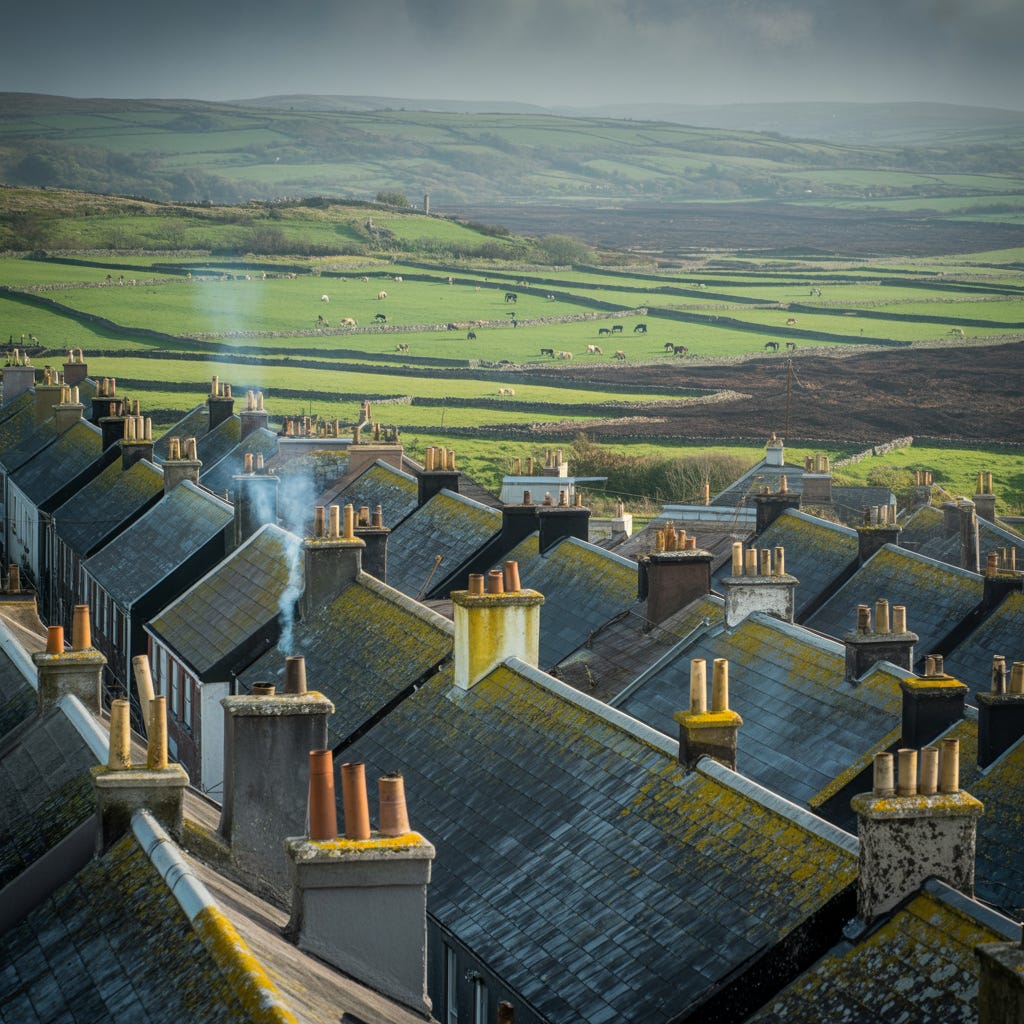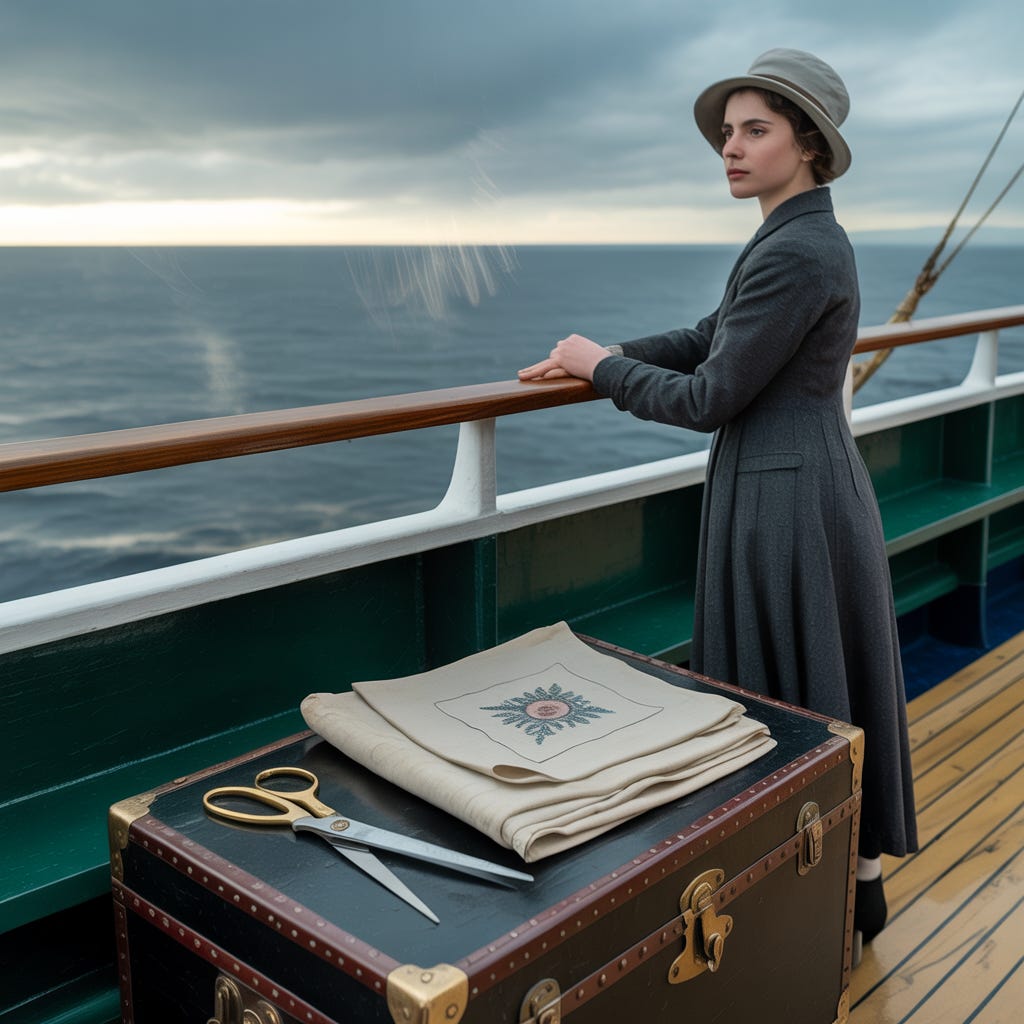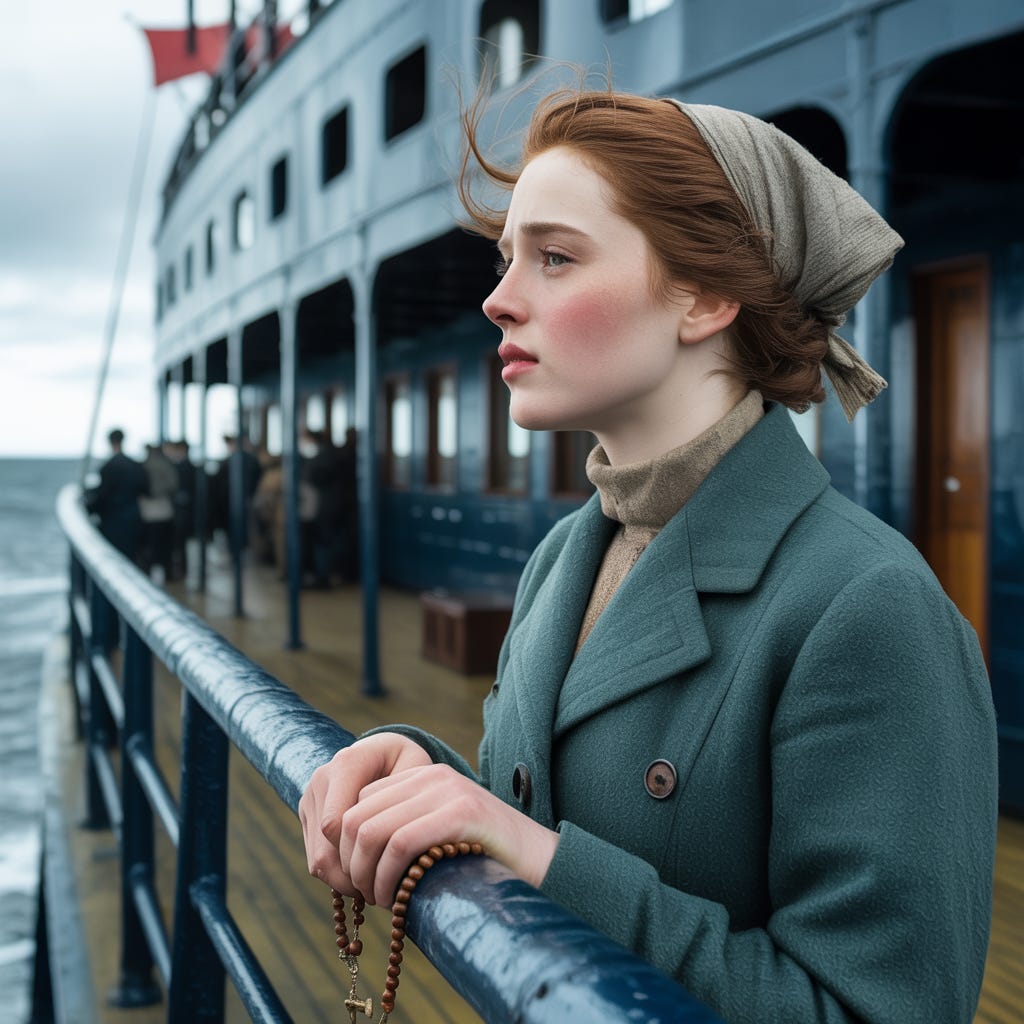The Story Behind the Story
Image by Ideogram 3.0 - August 2025
Some stories don’t begin with a plot—they begin with a place. For me, that place was Skibbereen, County Cork: a town forever marked by the memory of the Great Famine. It was there, in the imagined life of a seamstress named Margaret O’Sullivan, that I found the thread of a tale I couldn’t let go of.
Threads of Skibbereen follows Margaret’s first-person journey from a windblown hillside cottage in post-famine Ireland to the crowded streets of Boston’s Irish quarter. This wasn’t just a fictional piece—it was a creative embodiment of the invisible stories I knew existed in my family lines and in the lives of countless Irish women whose hands held communities together, one stitch at a time.
But I didn’t stop at text. I wanted this to be more than a story—I wanted to see it. That’s where AI-assisted visual storytelling entered.
From Family History to Fictional Truth
Margaret is fictional, but her world is stitched from historical cloth. I imagined her as the eldest of seven, born in 1895 in a home still haunted by famine. She learned responsibility early, sewing before she could spell, caring for siblings while dreaming of artistry. She bore the burden of survival, then found her spark in thread and rebellion, eventually leaving her homeland with little more than her mother’s scissors, a scrap of linen, and a promise.
In writing her story, I wove together Irish social history, oral storytelling rhythms, and the emotional realism that often gets lost in census data and parish registers.
Structuring the Story Through a Visual Framework
To give the narrative depth and coherence, I built a visual story map to chart Margaret’s emotional, geographical, and symbolic journey. Each act in her life is rooted in a different landscape, guided by motifs and themes.
Here’s a glimpse:
Act I: Roots in the Soil of Sorrow—Patchwork linen, famine shadows, duty as eldest daughter
Act II: The Spindle and the Spark—Celtic motifs, artistic awakening, cultural identity
Act III: Stitching in the Dark—Clandestine mending for Volunteers, loss, moral clarity
Act IV: The Great Crossing—Cobh harbour, a trunk wrapped in linen, the ache of farewell
Act V: Threads of the New World—Bridal veils, legacy in stitches, rediscovery through a grandniece
Epilogue: The Seam and the Silence—Final reflections from a Boston attic, tea cooling beside her needlework
This framework guided not just the writing but the imagery.
Creating Companion Images with AI
Image by Ideogram 3.0, August 2025
To illustrate key moments in Margaret’s journey, I used the “Worksheet for Image Generators for Family History Projects”—a practical tool that helped me move from story vision to image prompt.
Steps included:
Choosing the right tool: I primarily used Ideogram 3.0 and Canva for their photorealistic styles and ease of editing.
Note: I access my image generators from within my paid account at Abacus.aiCrafting detailed prompts: For example, from this simplistic prompt to a more detailed prompt.
“Early 20th-century Irish seamstress in candlelit cottage, hand-stitching a torn Volunteer coat, with thread basket and rain streaked window.”
I found that if I used a simple prompt like this one inside the image generator tool Ideogram 3.0, it would transform the simple prompt into a detailed and comprehensive prompt that I could use for different AI models and image generators.
A photorealistic image capturing a quiet, intimate moment inside a rustic, early 20th-century Irish cottage at night. The scene is illuminated by the soft, warm, flickering glow of a single candle resting in a simple tin holder on a worn wooden table. A young Irish seamstress, with her hair styled in a simple updo appropriate for the era, leans over her work with intense concentration etched on her face. She is wearing a simple, high-collared cotton blouse and a long, dark wool skirt. In her lap lies a heavy, dark green Volunteer coat, and her skilled hands are meticulously hand-stitching a visible tear in the sleeve. One hand holds the fabric taut, while the other guides a needle and dark thread through the thick material. Next to her on the table is a well-used wicker sewing basket filled with spools of thread, a silver thimble, and scissors. In the background, a small, paned window shows droplets of rain streaking down the glass, obscuring the view of the dark, wet night outside. The candlelight creates a strong chiaroscuro effect, casting deep shadows into the corners of the room and highlighting the rough texture of the whitewashed stone walls, the grain of the wooden furniture, and the focused expression of the seamstress. The atmosphere is one of solitary diligence and quiet melancholy.
My latest video in the Essential Genealogy 2.0 Channel at YouTube demonstrates my process:
Incorporating symbolic props: Mam’s scissors, embroidered spirals, linen bundles, a rediscovered sketchbook, green silk sash, “grá agus dóchas” stitch
Visuals: Celtic embroidery patterns, ledger sketchbooks, limestone spirals, bridal fittings, altar cloths, winter coats on dress forms
Themes: Resistance, sacrifice, awakening, grief, courage, transformation, Reflection, memory, hidden strength
These images became companions to the prose, evoking emotion and context that deepened the reader’s experience.
Bringing the Visuals and Words Together
I used visuals in multiple ways:
As chapter headers and scene openers
In an interactive timeline tracing Margaret’s journey from Skibbereen to Boston
Paired with quotes from the story for visual social media storytelling
Each act of her life was illustrated by one evocative scene or object—a needle, a stone circle, or a fog-drenched ship deck. These visuals weren’t decorative. They were narrative anchors.
What I Learned (and What You Might Try)
Here’s what this process taught me:
AI tools, when used with care, amplify storytelling rather than replace it.
Visual prompts need as much emotional clarity as prose—focus on atmosphere, gesture, and detail.
Blending visuals with historical narratives can surface empathy and intimacy in ways that words alone may not.
If you’re a family historian or narrative genealogist, consider starting with a visual story map like mine. Then explore image creation not just to depict your ancestor’s world, but to understand it.
Why Stories Like Margaret’s Matter
Margaret O’Sullivan never existed. But her life echoes through every woman who bent over a sewing basket by firelight, every child who boarded a ship with a promise sewn into their hem.
By combining narrative structure with generative image tools, we breathe life into the silent corners of history.
And that is the work of a story.
Resources & Links
🧵 Explore the full story: Threads of Skibbereen
Your Turn: Have you used image generation or story mapping in your ancestral storytelling? Share your creations, reflections, or questions in the comments below. Let’s stitch these hidden stories together.






Thanks for the tips! Very helpful.
I can't wait to check out your video and tips. I use Canva to create images of my characters which helps me keep them straight. This technique can strengthen setting as well.
Loved this line: ...every child who boarded a ship with a promise sewn into their hem.